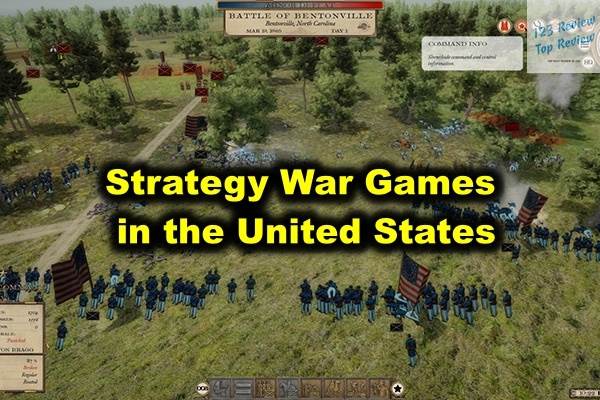Strategy war games have long been a staple in the gaming industry, captivating players with their intricate mechanics, immersive themes, and the intellectual challenge they present.
In the United States, the genre has a robust following, with numerous titles offering a wide array of experiences. In this article, 123 Review delves into the best strategy war games available, gameplay mechanics, player engagement, thematic elements, influences on game design, and future trends shaping the genre.

Best Strategy War Games Available
Popular Titles in 2024
In 2024, the strategy war game landscape is dominated by several standout titles. Leading the pack is “Total War: Pharaoh,” which combines the strategic depth of the Total War series with the rich historical context of ancient Egypt. Players can immerse themselves in the grand scale of the game, managing resources, leading armies, and engaging in epic battles.
Another popular title is “Company of Heroes 3,” which continues the legacy of its predecessors with intense, tactical gameplay set in World War II. The game’s realistic combat mechanics, detailed environments, and compelling narrative make it a must-play for strategy enthusiasts.
“Crusader Kings III” also remains a favorite, offering players the chance to control a medieval dynasty, navigate complex political landscapes, and expand their influence through warfare, diplomacy, and intrigue. Its deep role-playing elements and emergent storytelling keep players engaged for hours on end.
Classic Games That Remain Timeless
Certain strategy war games have achieved a timeless status, continuing to captivate players years after their release. “Civilization VI,” for example, remains a cornerstone of the genre. Its turn-based gameplay, where players build and expand civilizations from ancient times to the modern era, offers endless replayability. The game’s depth, combined with its accessibility, makes it appealing to both newcomers and veterans.
“Age of Empires II” is another classic that has endured the test of time. First released in 1999, the game has seen numerous expansions and a definitive edition, keeping it fresh and relevant. Its blend of real-time strategy and historical accuracy provides a captivating experience that continues to draw players.
Innovative New Entries in the Genre
The strategy war game genre is constantly evolving, with new titles introducing innovative mechanics and fresh perspectives. “Humankind” is a prime example, allowing players to rewrite the course of human history by guiding their civilization through different eras. The game’s unique culture-building mechanics and dynamic map evolution offer a novel take on the genre.
“Iron Harvest,” set in an alternate history inspired by the 1920s, combines traditional real-time strategy gameplay with dieselpunk elements. Its focus on mechs and infantry tactics, coupled with a strong narrative, sets it apart from more conventional titles.
Gameplay Mechanics
Turn-Based vs Real-Time Strategy
One of the key distinctions within the strategy war game genre is the difference between turn-based and real-time strategy (RTS) games. Turn-based games, like “XCOM 2,” allow players to carefully plan each move, emphasizing strategic decision-making and foresight. Players take turns controlling their units, which adds a layer of tactical depth and requires careful planning.
In contrast, real-time strategy games, such as “StarCraft II,” demand quick thinking and fast reactions. Players must manage resources, build units, and conduct combat operations in real-time, creating a dynamic and often frenetic gameplay experience. The RTS genre rewards players who can think on their feet and make rapid, effective decisions.
Resource Management Systems
Resource management is a cornerstone of many strategy war games. Efficiently gathering and utilizing resources is crucial to building armies, constructing buildings, and achieving victory. In games like “StarCraft II,” players must manage minerals and gas, balancing their economy with military production. This adds a strategic layer where players must decide whether to focus on economic growth or military expansion.
Similarly, in “Age of Empires IV,” players gather resources like food, wood, gold, and stone, which are essential for building units and advancing through the ages. Effective resource management can be the difference between victory and defeat, requiring players to adapt their strategies based on the availability and control of resources.
Combat Mechanics and Unit Types
Combat mechanics and the diversity of unit types significantly impact the gameplay experience in strategy war games. In “Total War: Warhammer II,” players have access to a wide range of units, from basic infantry to powerful monsters and artillery. Each unit type has strengths and weaknesses, and understanding these dynamics is key to successful combat.
Games often feature complex combat mechanics that require players to consider factors such as terrain, unit positioning, and morale. For example, flanking an enemy in “Total War: Warhammer II” can cause a morale drop, leading to a quicker rout. Understanding and exploiting these mechanics adds a layer of strategic depth to the game.
Player Engagement and Community
Two-Player vs Multiplayer Options
Strategy war games offer various multiplayer options, catering to different player preferences. Two-player modes, found in games like “Command & Conquer: Red Alert 3,” provide intense head-to-head battles that test players’ strategic prowess. These modes often emphasize direct competition and quick decision-making.
On the other hand, games like “Total War: Warhammer II” support larger multiplayer battles involving multiple players. These modes can include cooperative campaigns where players team up against AI opponents or competitive matches where each player controls their own faction. The social interaction and teamwork required in these modes enhance the overall gaming experience.
Online Platforms and Digital Adaptations
The advent of online platforms and digital adaptations has transformed the strategy war game genre. Services like Steam and Epic Games Store offer easy access to a vast library of games, allowing players to discover and download new titles with ease. Online platforms also provide a space for players to share mods, discuss strategies, and form communities.
Digital adaptations of classic board games, such as “Risk” and “Axis & Allies,” bring traditional gameplay to the digital realm. These adaptations often include enhancements like online multiplayer, improved graphics, and additional scenarios, making them accessible to a wider audience.
Community Events and Tournaments
Community events and tournaments play a crucial role in maintaining player engagement in strategy war games. Competitive scenes for games like “StarCraft II” and “Age of Empires II” feature regular tournaments, drawing players from around the world to compete for prestige and prizes. These events foster a vibrant community and encourage skill development.
Tournaments also provide a platform for players to showcase their strategies and innovations, contributing to the evolution of the game. Community-driven events, such as modding competitions and fan conventions, further enrich the gaming experience by bringing players together to celebrate their shared passion.
Thematic Elements
Historical Contexts and Settings
Historical contexts and settings provide rich backdrops for strategy war games, immersing players in specific time periods and allowing them to relive and reshape significant events. “Total War: Three Kingdoms,” for instance, is set in ancient China during the Three Kingdoms period, offering a deep and immersive experience with its detailed historical narrative and authentic cultural elements.
“Hearts of Iron IV” focuses on World War II, allowing players to control nations and guide them through the conflict. The game’s attention to historical detail and complex political systems create a rich, educational experience that appeals to history buffs and strategy enthusiasts alike.
Fantasy vs Real-World Themes
Strategy war games often explore both fantasy and real-world themes, offering players a variety of settings and narratives. “Warhammer 40,000: Dawn of War” immerses players in a dark, futuristic universe filled with powerful factions and epic battles. The game’s rich lore and fantastical elements provide a stark contrast to more grounded, historically-based games.
In contrast, “Steel Division 2” focuses on realistic military scenarios, specifically the Eastern Front of World War II. The game’s attention to historical accuracy and detailed unit representations provide an immersive experience that appeals to fans of military history.
Cultural Significance of Strategy War Games
Strategy war games reflect and influence cultural perceptions of history and conflict. They provide a platform for exploring complex themes and ethical dilemmas, contributing to broader cultural discussions about warfare and strategy. Games like “Civilization VI” allow players to explore different civilizations and their contributions to human history, fostering a deeper appreciation for cultural diversity.
The cultural significance of strategy war games extends beyond their entertainment value. They can serve as educational tools, offering insights into historical events and encouraging players to think critically about the decisions and consequences of warfare.
Influences on Game Design
Key Designers and Their Impact
Prominent game designers have left a lasting impact on the strategy war game genre. Sid Meier, known for the “Civilization” series, has been instrumental in shaping the genre with his focus on turn-based strategy and empire-building. His games emphasize strategic depth, replayability, and educational value, making them beloved by players worldwide.
Shigeru Miyamoto, famous for his work on “Pikmin,” has also contributed to the genre with his unique approach to strategy and resource management. “Pikmin” combines real-time strategy elements with puzzle-solving and exploration, offering a fresh and innovative gameplay experience.
Evolving Game Mechanics Over Time
Game mechanics in the strategy war genre have evolved significantly over the years. Early titles like “Command & Conquer” laid the groundwork for resource management and base-building mechanics, which have since been refined and expanded in modern games. Innovations such as dynamic weather systems, advanced AI, and procedurally generated maps have enhanced the complexity and realism of the genre.
Modern games like “Total War: Three Kingdoms” and “Crusader Kings III” incorporate intricate political and social systems, adding layers of depth to the strategic gameplay. These advancements reflect the genre’s evolution and its ability to adapt to changing player preferences and technological advancements.
Innovations in Visual and Audio Design
Visual and audio design innovations have significantly enhanced the immersive experience of strategy war games. High-fidelity graphics and dynamic soundscapes create a more engaging and realistic gameplay environment. “Total War: Three Kingdoms,” for example, features stunning visuals and detailed character models, bringing the historical setting to life.
Audio design also plays a crucial role in creating an immersive experience. Soundtracks composed specifically for the game, realistic sound effects, and voice acting contribute to the atmosphere and emotional impact of the game. These elements combine to create a cohesive and compelling experience that draws players into the game world.
Future Trends in Strategy War Games
Emergence of Hybrid Genre Games
Hybrid genre games are becoming increasingly popular, blending strategy elements with other genres to create unique and diverse gameplay experiences. “Mount & Blade II: Bannerlord” combines real-time strategy with role-playing mechanics, allowing players to lead armies, engage in combat, and manage their kingdom. This hybrid approach offers a rich and varied gameplay experience that appeals to a broad audience.
Hybrid games like “Total War: Warhammer” integrate elements of fantasy, strategy, and role-playing, providing players with a multi-faceted experience. The emergence of these hybrid games reflects the genre’s ability to innovate and adapt to changing player preferences.
Technological Advancements in Gameplay
Technological advancements are driving innovation in strategy war games, providing new levels of complexity and immersion. Enhanced AI allows for more realistic and challenging opponents, while procedural generation creates dynamic and varied game worlds. These advancements enable developers to create richer and more engaging gameplay experiences.
Virtual reality (VR) is also poised to make a significant impact on the genre. VR integration can offer players a more immersive and interactive experience, allowing them to view and interact with the game world in new and exciting ways. As VR technology continues to advance, we can expect to see more strategy war games incorporating this technology.
Predictions for the Next Decade
The next decade promises exciting developments in the strategy war game genre. With the rise of cloud gaming, players will have access to a wider range of games and the ability to play on various devices without the need for powerful hardware. This accessibility will likely lead to an increase in the genre’s popularity.
Advancements in AI and machine learning will also shape the future of strategy war games. More sophisticated AI opponents and adaptive gameplay experiences will create a more challenging and engaging experience for players. Additionally, we can expect continued innovation in game mechanics, visual design, and storytelling, pushing the boundaries of what strategy war games can offer.
In conclusion, strategy war games continue to captivate players with their intricate mechanics, immersive themes, and intellectual challenges. The genre’s evolution, driven by innovative game design and technological advancements, ensures that it will remain a vital and exciting part of the gaming landscape for years to come.





